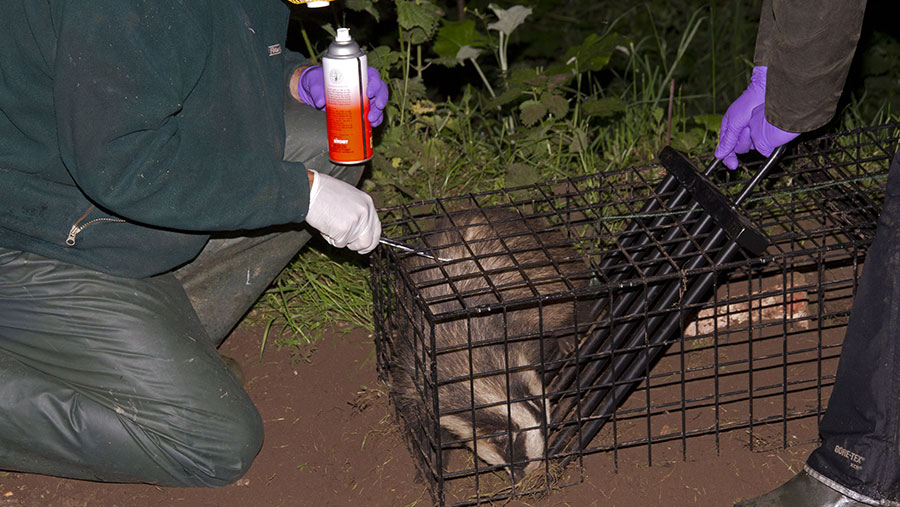Badger and cattle TB vaccination: The situation now
 © FLPA/John Hawkins/REX-Shutterstock
© FLPA/John Hawkins/REX-Shutterstock With controversy continuing to rage about badger culling, and questions still raised about the government’s “test and slaughter” policy for cattle, Defra is pumping millions of pounds a year into bovine TB vaccination research.
The department has invested in both injectable and oral vaccination programmes for badgers, and continues to fund an established research programme for immunising cattle.
See also: How a beef enterprise has adapted to overcome TB
Badger vaccination
Injectable programmes
A shortage of Bacillus Calmette-Guérin (BCG) vaccine had stalled UK vaccination programmes throughout 2016, but stocks have recovered and Defra reopened its Badger Edge Vaccination scheme (Bevs) for applications in September.
Vaccination under Bevs, which provides 50% grant funding for groups to protect healthy badgers outside hotspot areas, is expected to begin next spring.
In Wales, large-scale vaccination programmes have already been carried out by government operators. Figures show that, after four years, 5,000 vaccine doses have been administered and up to 85% of badgers in the treatment areas could have some immunity.
Northern Ireland’s Department of Agriculture, Environment and Rural Affairs (Daera) also uses a “test and vaccinate or remove” (TVR) policy. The programme has run through the summer and early autumn months since its inception in 2014.
Badgers are captured, tested, micro-chipped and vaccinated against bovine TB. Any badgers which test positive for the disease are destroyed.
The latest figures show 586 badger trappings in 2016 across a 100sq km area around Banbridge, County Down. More than half of these were recaptured animals, highlighting one of the major difficulties in injectable vaccine programmes.
Oral vaccine
Delivering a vaccine orally, via a bait, offers a simpler and less labour-intensive approach, but there are still difficulties to surmount.
One challenge has been the viability of the vaccine-treated bait which is reduced by the badger’s digestive system.
However, this year there have been positive early results from field trials in Ireland using a lipid-coated vaccine which withstands the gut action. More than 300 treated badgers showed a stronger immune response to the disease and, at post-mortem examination, far fewer numbers of TB lesions.
Further results from the trial are expected early in 2018.
Cattle vaccination
The lion’s share of Defra’s £3.62m TB research budget for 2016-17 was spent on developing a vaccine to protect cattle. But the longstanding difficulties that have prevented the marketing of a cattle vaccine persist.
One of those is that BCG vaccines interfere with the tuberculin skin test that is used to identify the disease in cattle.
That means current research has two main aims. The first is to develop a vaccine that protects animals against TB. The second is to refine tests which can differentiate between vaccinated and disease-infected animals.
Vaccine efficacy
Because a vaccine cannot be used within the confines of EU law, Defra and the Animal Plant Health Agency (Apha) have set up field trials in partnership with Ethiopia, where up to 50% of dairy herds are infected with bovine TB.
The latest results show that between 56% and 68% of vaccinated animals did not succumb to the disease.
Encouragingly the BCG vaccination programme also slowed down the progression, severity and excretion of TB bacteria, resulting in reduced transmission between animals, Apha said.
However, to eradicate the disease using a vaccination programme would require a minimum of 80% of the target population to be successfully immunised, so other methods of control remain vital.
Differentiate infected from vaccinated animals (Diva) test
Apha scientists have also made progress with the so-called Diva test, which is needed to distinguish between infected and vaccinated animals.
Recent trials have used a gamma-interferon based test to detect certain antigens which act as markers in the bovine TB bacterium. These antigens are not present in the BCG vaccine, making it possible to distinguish between vaccinated and TB infected animals.
Apha has told Farmers Weekly it now has two candidate skin tests that it aims to take forward in field trials.
